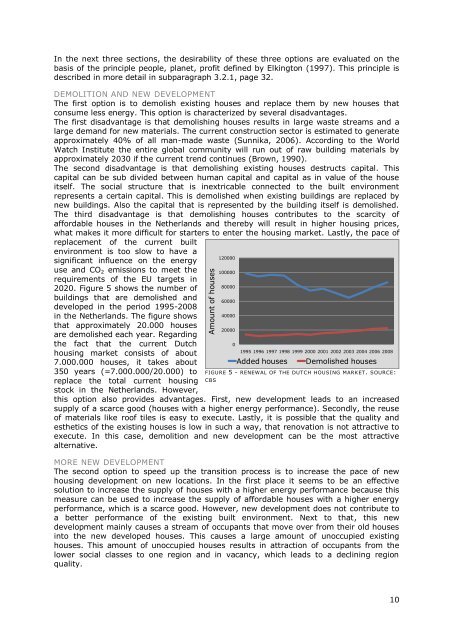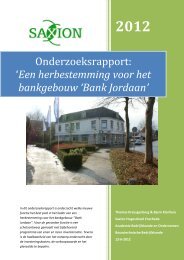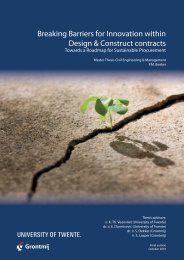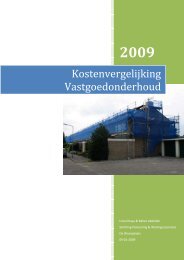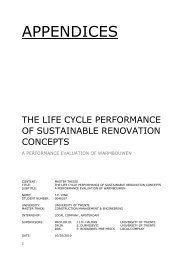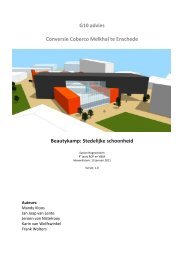the life cycle performance of sustainable renovation concepts
the life cycle performance of sustainable renovation concepts
the life cycle performance of sustainable renovation concepts
- No tags were found...
You also want an ePaper? Increase the reach of your titles
YUMPU automatically turns print PDFs into web optimized ePapers that Google loves.
Amount <strong>of</strong> housesIn <strong>the</strong> next three sections, <strong>the</strong> desirability <strong>of</strong> <strong>the</strong>se three options are evaluated on <strong>the</strong>basis <strong>of</strong> <strong>the</strong> principle people, planet, pr<strong>of</strong>it defined by Elkington (1997). This principle isdescribed in more detail in subparagraph 3.2.1, page 32.DEMOLITION AND NEW DEVELOPMENTThe first option is to demolish existing houses and replace <strong>the</strong>m by new houses thatconsume less energy. This option is characterized by several disadvantages.The first disadvantage is that demolishing houses results in large waste streams and alarge demand for new materials. The current construction sector is estimated to generateapproximately 40% <strong>of</strong> all man-made waste (Sunnika, 2006). According to <strong>the</strong> WorldWatch Institute <strong>the</strong> entire global community will run out <strong>of</strong> raw building materials byapproximately 2030 if <strong>the</strong> current trend continues (Brown, 1990).The second disadvantage is that demolishing existing houses destructs capital. Thiscapital can be sub divided between human capital and capital as in value <strong>of</strong> <strong>the</strong> houseitself. The social structure that is inextricable connected to <strong>the</strong> built environmentrepresents a certain capital. This is demolished when existing buildings are replaced bynew buildings. Also <strong>the</strong> capital that is represented by <strong>the</strong> building itself is demolished.The third disadvantage is that demolishing houses contributes to <strong>the</strong> scarcity <strong>of</strong>affordable houses in <strong>the</strong> Ne<strong>the</strong>rlands and <strong>the</strong>reby will result in higher housing prices,what makes it more difficult for starters to enter <strong>the</strong> housing market. Lastly, <strong>the</strong> pace <strong>of</strong>replacement <strong>of</strong> <strong>the</strong> current builtenvironment is too slow to have asignificant influence on <strong>the</strong> energyuse and CO 2 emissions to meet <strong>the</strong>requirements <strong>of</strong> <strong>the</strong> EU targets in2020. Figure 5 shows <strong>the</strong> number <strong>of</strong>buildings that are demolished anddeveloped in <strong>the</strong> period 1995-2008in <strong>the</strong> Ne<strong>the</strong>rlands. The figure showsthat approximately 20.000 housesare demolished each year. Regarding<strong>the</strong> fact that <strong>the</strong> current Dutchhousing market consists <strong>of</strong> about7.000.000 houses, it takes about350 years (=7.000.000/20.000) toreplace <strong>the</strong> total current housingstock in <strong>the</strong> Ne<strong>the</strong>rlands. However,FIGURE 5 - RENEWAL OF THE DUTCH HOUSING MARKET. SOURCE:CBS12000010000080000600004000020000this option also provides advantages. First, new development leads to an increasedsupply <strong>of</strong> a scarce good (houses with a higher energy <strong>performance</strong>). Secondly, <strong>the</strong> reuse<strong>of</strong> materials like ro<strong>of</strong> tiles is easy to execute. Lastly, it is possible that <strong>the</strong> quality andes<strong>the</strong>tics <strong>of</strong> <strong>the</strong> existing houses is low in such a way, that <strong>renovation</strong> is not attractive toexecute. In this case, demolition and new development can be <strong>the</strong> most attractivealternative.MORE NEW DEVELOPMENTThe second option to speed up <strong>the</strong> transition process is to increase <strong>the</strong> pace <strong>of</strong> newhousing development on new locations. In <strong>the</strong> first place it seems to be an effectivesolution to increase <strong>the</strong> supply <strong>of</strong> houses with a higher energy <strong>performance</strong> because thismeasure can be used to increase <strong>the</strong> supply <strong>of</strong> affordable houses with a higher energy<strong>performance</strong>, which is a scarce good. However, new development does not contribute toa better <strong>performance</strong> <strong>of</strong> <strong>the</strong> existing built environment. Next to that, this newdevelopment mainly causes a stream <strong>of</strong> occupants that move over from <strong>the</strong>ir old housesinto <strong>the</strong> new developed houses. This causes a large amount <strong>of</strong> unoccupied existinghouses. This amount <strong>of</strong> unoccupied houses results in attraction <strong>of</strong> occupants from <strong>the</strong>lower social classes to one region and in vacancy, which leads to a declining regionquality.01995 1996 1997 1998 1999 2000 2001 2002 2003 2004 2006 2008Added housesDemolished houses10


